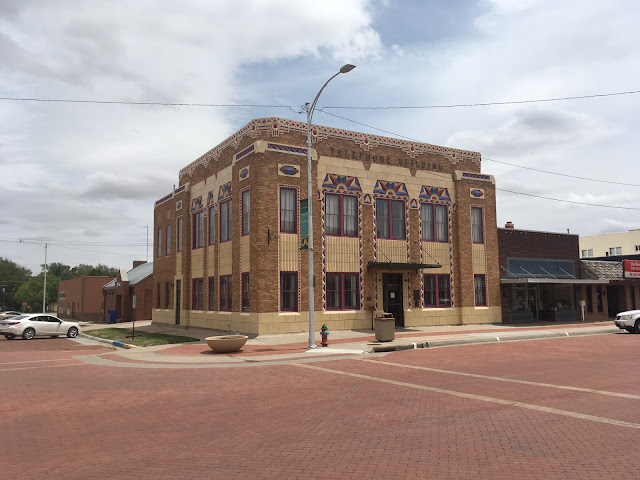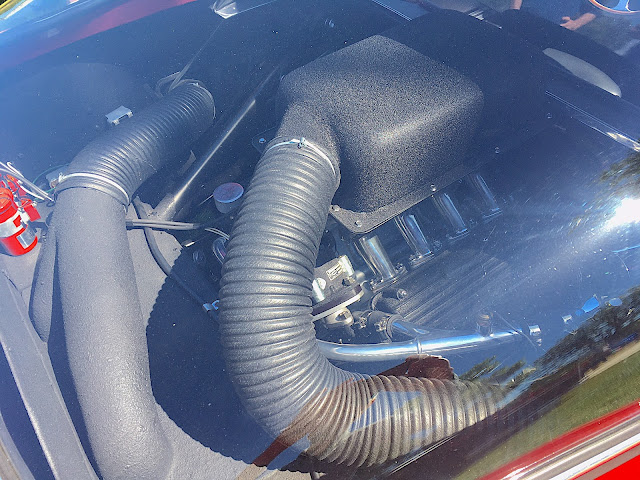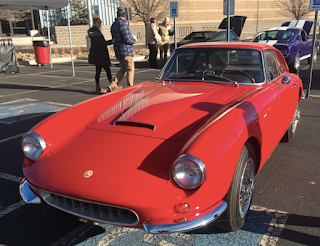Driving west across Kansas in late May, the hum of the Interstate delivers monotony in a way that even a surprising public radio show mixing jazz and classical Chinese music cannot dispel. You start looking for a place to stop for lunch, and notice a billboard advertising a technology center and a museum in Goodland. So you stop there. There's what may be the world's largest Van Gogh reproduction (above) sitting on an 80-foot easel, and a modest but immaculate Welcome Center (below) where a helpful staffer directs you to a good restaurant for lunch...
Driving towards downtown Goodland, you see some of the signs that have become familiar on your drive through farm country: sound but apparently abandoned structures like the gas station below, and some vacant shop fronts in solid old brick buildings. But there are signs of hope too. The usual suspects in undermining small downtowns, such as a fleet of fast food franchises out near Interstate 70, are less evident here. There's a Dollar General, but it seems to have been kicked to the curb out in an industrial park. On the plus side, there's the Northwest Kansas Technical College, and the High Plains Museum, open since 1959. And there's also the Pioneer Dog Park for exercising your pooch, not far from the Welcome Center.
You seek lunch at The Bricks, an old establishment named after its construction material, huddled in front of vast white grain elevators at the edge of an improbably wide, brick-paved Main Street…
The Bricks, owned by a nice lady named Maria, offers good Mexican food and friendly service. A few minutes after I sit down, half a dozen locals walk in...
The expansive width and length of Main Street, paved with brick since the early Twenties, are reminders of how prosperous farm towns were before the Great Depression, and even for awhile after it ended, when family farms were still the primary approach to farming. The rise of big corporate farms favored by government policies and by food processing conglomerates, the expansion of fast food franchises and retail operations like Walmart along Interstate highways, and the recent rise of Amazon have all had a damaging impact on downtowns that serve farm country...
This lot filled with old cars prompted the thought that back in its most prosperous times, Goodland (pop. about 4,000 today) would have had a showroom or two full of shiny new cars, trucks and farm tractors. Someone connected with this lot seems to have a real fondness for Mercury's offerings from the late Forties and early Fifties; the '53 two-door sedan below seems to be waiting for whoever chopped the top to come back and complete its transformation into a custom rod...
The United Telephone Building, at 1003 Main, is a reminder of the useful infrastructure and rich history that often get abandoned when an old downtown becomes vacant. It dates from 1931, when United's in-house designer Colby Hamilton selected Native American motifs to honor the Western plains location. For reasons that probably include what was trending in the heyday of Art Deco, he chose brightly colored tiles with an Aztec theme, and decorated the ceilings with split telephone poles painted in similar patterns.
The building was added to the National Register of Historic Places in 2017, and has been under restoration since then by the Sherman County Historical Society. Their plan is to put the building to use as a historical research center.
Old structures, and old infrastructure, represent one of our most underutilized resources, especially in rural cities with shrinking downtowns. One element of successful downtown revivals is that historic architecture like the Telephone Building is plugged back into the life of the town by taking on some civic, commercial, or residential function. Organizations like Main Street America (www.mainstreet.org) and Upstairs Downtown (upstairsdowntown.com) have long been in the vanguard of the movement to revive America's small and mid-sized downtowns. Since 1980, efforts connected with Main Street America have resulted in rehabilitating over 314,000 buildings, creating over 700,000 jobs and starting over 160,000 businesses. Upstairs Downtown has facilitated successful adaptive re-use projects in downtowns across the country, providing expertise that brings new retail and service businesses into ground floor spaces, while renovated spaces "upstairs" can provide space for living. In an era when working from home has become a trend, and housing shortages are in the news, our often vacant spaces in overlooked downtowns are an underutilized resource.
Four blocks away from the old United Telephone Building, we encountered a more recent addition to the Goodlands streetscape. The Dental Arts building dating from 2001 sits on a former hospital site in a tree-lined neighborhood where downtown businesses shade into single-family residences, including two designed by Frank Lloyd Wright's students. In their design for Dental Arts, architects at T.H.E. Design have made a deft transition between residential scale and the welcoming public space of the entry porch, where clustered steel columns feature horizontal brackets that echo the dark courses of brick...
Dark green steel headers above the glass and brick emphasize the horizontal feeling as well as the shade under the deep eaves. Glazing extending to the floor in dental offices is intended to have a calming effect on patients, who can watch well-fed squirrels at play on the tree-shaded lawn. Goodland's Dental Arts is such a careful and sensitive piece of work that I wanted to go inside to ask about the building on the day I happened upon it. But the waiting room was full of customers, proof that this piece of architecture is doing its job, so I gave Dental Arts* a call when I got home.
If adapting old structures to new uses, as in the case of the Telephone Building, is a sign of respect for the past, providing a new and welcoming work of architecture to serve the public's heath needs is sign of hope for the future. And hope is one of those things that our small towns and cities could use right now.
*Footnote: We want to thank Dawn Jolly of Goodland Dental Arts for providing background information on the Dental Arts design, and on the landmark United Telephone Building.
Photo Credits:
Top: Wikimedia
2nd, 3rd & 7th: Dr. Marcus Nashelsky
All other photos are by the author.














































